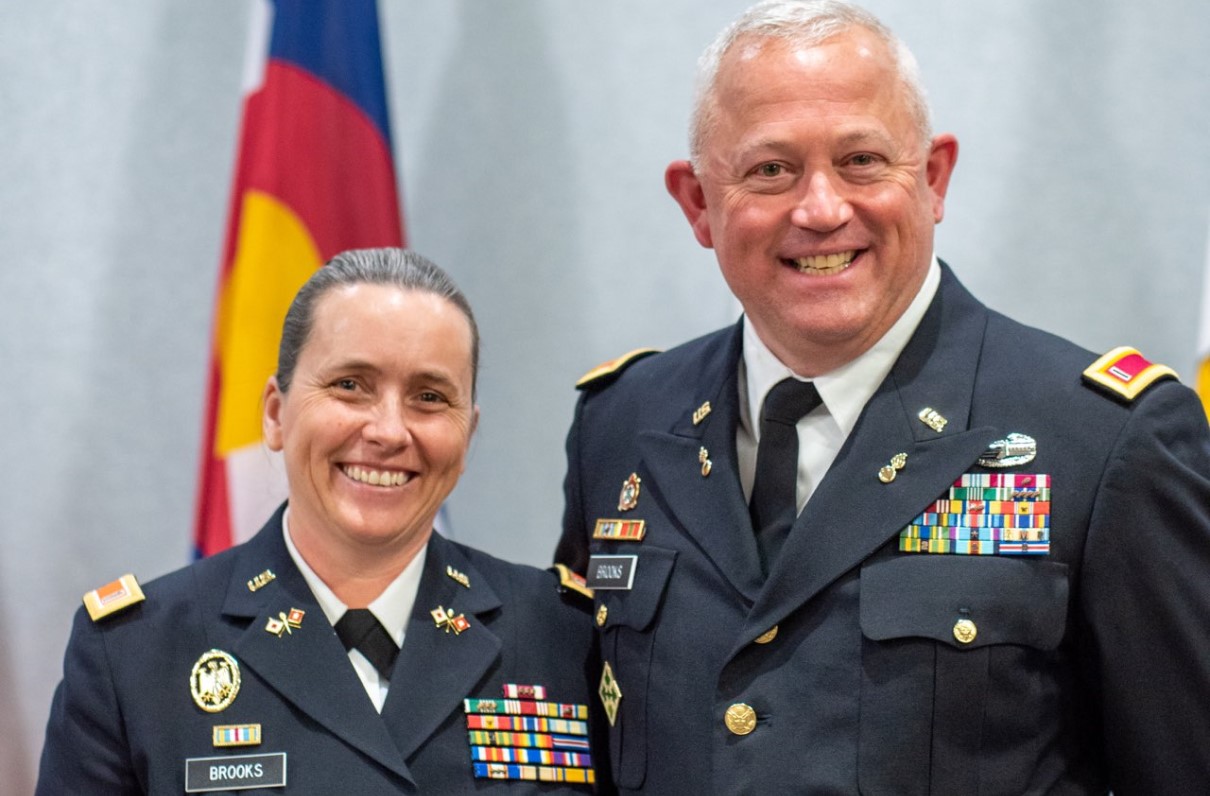Imagine seeing two unicorns in the same place.
That’s how unusual Shelly and Brian Brooks are in the Army National Guard. The married couple are both chief warrant officer 5s, a rank only a fraction of warrant officers in the Army achieve.
The National Guard Bureau (NGB) chief warrant officers were sworn in together at that rank in December. Shelly, a Life Member of MOAA, is a signal officer while husband Brian, also a MOAA member, works in logistics. The couple met at Camp Atterbury, Ind., in 2006 and spent 10 years at the Colorado Army National Guard together before moving to the NGB in 2018.
It’s no surprise to those who know the couple that they were able to achieve this prestigious rank. CW5 Linda Blincoe, USA (Ret), knew Shelly had what it took to become a CW5 as soon as Shelly started working under her in Colorado.
“Shelly is very gung-ho, very energetic,” said Blincoe, who served as the first female command chief warrant officer for the Colorado Army National Guard before retiring in 2011. “She always wants to do what is right, and she doesn’t mind telling you if you aren’t.”
[RELATED: More MOAA Members in the Spotlight]
“Both are very approachable leaders,” said Col. Isaac B. Martinez, chief information officer of the Colorado Army National Guard. “Shelly always provides sound but true guidance or feedback. Brian has a calm, genuine spirit, and is an effective leader that truly owns his craft.”
To reach the top of the warrant officer ranks, soldiers have to put in at least 20 years of service, pass multiple courses including the Warrant Officer Senior Service Education course, and work at least five years as a chief warrant officer 4, according to Martinez. After all that, they must go through an interview process and be selected for promotion by their peers.
The rank is even more unusual in Shelly’s case: Out of the 54 states and U.S. territories, only 11 have assigned Army senior signal systems technicians, Martinez said. Signal officers supervise and manage the operation of telecommunications networks, network systems equipment, and associated personnel.
Shelly was the top subject-matter expert for signal officers in the entire state, according to CW5 Steve Imeraj, USA (Ret), who served as command chief warrant officer for the Colorado National Guard.
Her drive to be the best started as a child and continued when she joined the Guard in 1990. Frustrated with the way she was treated by co-workers while working on the help desk, Shelly started her warrant officer journey in 2003.
[RELATED: MOAA Seeks Submissions for Member Spotlight]
“What drives me is when people tell me no, and they’re placing limits on me,” said Shelly, who has a master’s degree in information technology. “When people say I can’t do that, well, why can’t I do that? God doesn’t say I can’t do that.”
Brian has always enjoyed helping people get things done, an attitude he had while working in the civilian ranks in the maintenance field. Seeing other people succeed has become even more fulfilling as he has risen through the warrant officer ranks.
“When you are young in rank, you don’t have as much influence,” said Brian. “But when you become senior, you can have a lot of influence and help make positive changes. I love wearing the uniform, too.”
As Imeraj’s force integration readiness officer, Brian was a “consummate professional.” And along with Shelly, Brian excelled in his role as a training, advising and counseling (TAC) officer, Imeraj said.
“They both are master level technical and tactical experts … and both are highly qualified to be a command chief warrant officer for any state,” said Imeraj.
While Brian and Shelly’s résumé are equally impressive, their chemistry wasn’t – at least not when they first met. When Brian first worked with Shelly in Indiana as TACs, he said they were “on the wrong sheet of music.”
But two years later, they attended the same conference in March and hit it off. By that fall, Brian moved from his Army National Guard position in Iowa to be with Shelly in Colorado. A few months later, they were married, starting a blended family while eventually having two children together.
“I guess I figured out that Shelly was not this vicious TAC officer, that she is this loving, kindhearted person,” said Brian. “I saw how hard working she is, how she is always trying to do the best at everything.”
“I was one of the smiling TAC officers,” laughed Shelly. “I smile even when I am really mad. I rarely yelled at my soldiers, maybe once or twice in eight years.”
Want to Help Servicemembers in Your Community?
Learn how you can make a difference with your local chapter.

